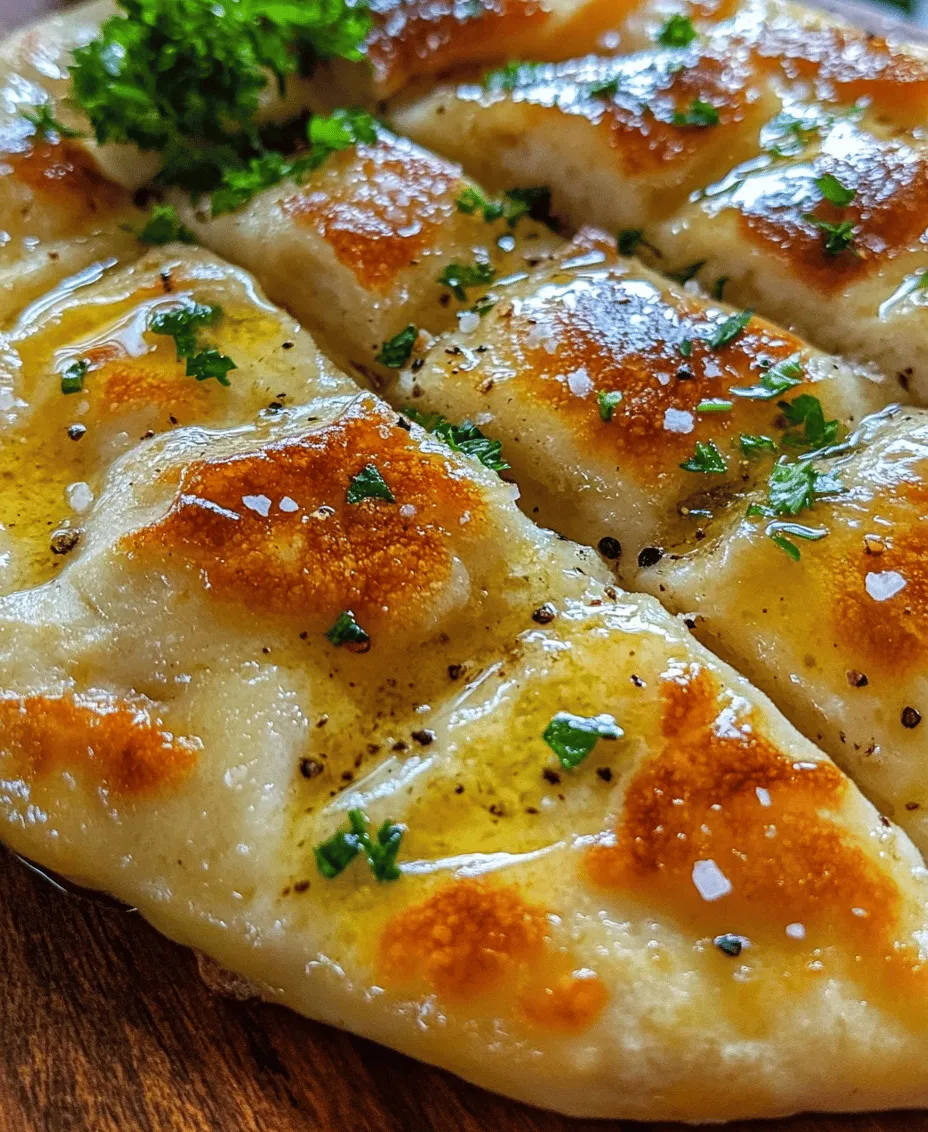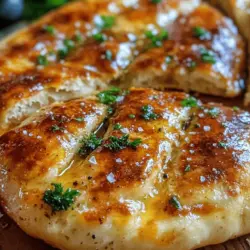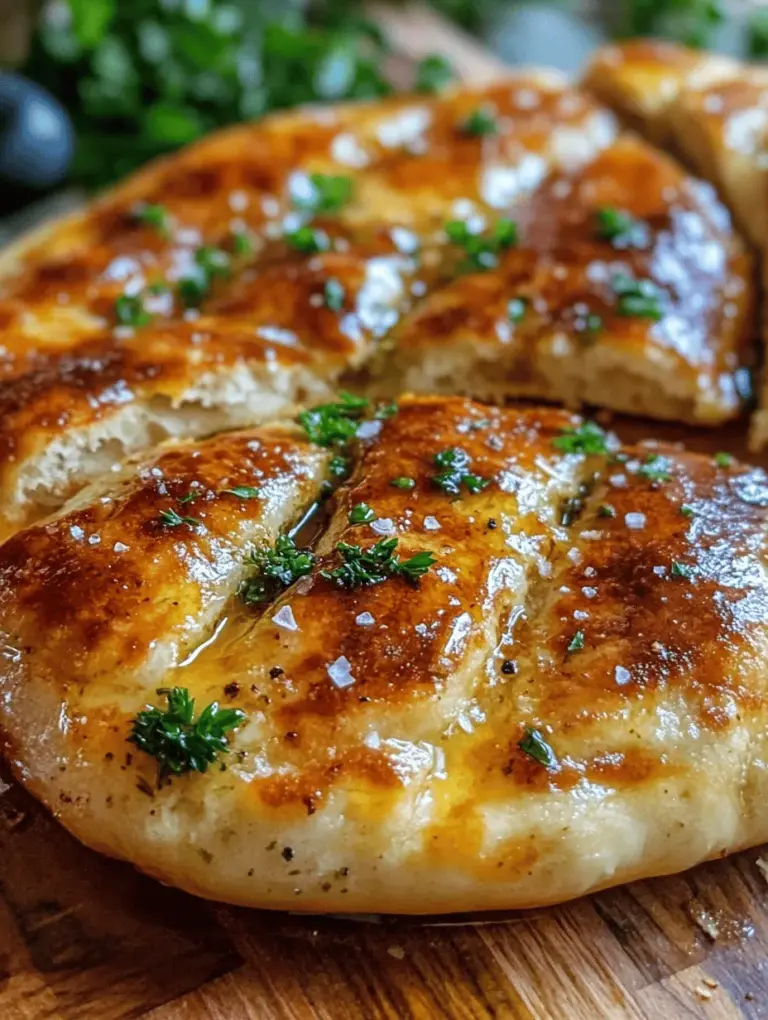Introduction
Flatbreads have captivated taste buds across cultures for centuries, becoming a staple in various cuisines from Indian naan to Middle Eastern pita. Their versatility allows them to accompany an array of dishes, whether used as a wrap, a scoop for dips, or simply enjoyed on their own with a drizzle of oil or a sprinkle of herbs. Among the myriad of flatbread recipes, the No Knead Garlic Flatbread with Liquid Batter stands out as a simple yet delicious option that requires minimal effort while delivering impressive results.
This recipe embraces the beauty of flatbreads by eliminating the need for kneading, making it accessible even for novice bakers. With just a few basic ingredients and minimal hands-on time, you can create a delightful, soft, and aromatic garlic flatbread that pairs beautifully with soups, stews, or even as a standalone snack. The unique liquid batter technique not only simplifies the process but also ensures a tender, airy texture that is sure to impress family and friends.
Understanding No Knead Baking
The no-knead baking technique has gained immense popularity among home bakers, and for good reason. At its core, this method relies on a longer fermentation time to develop gluten structure, allowing the dough to rise without the traditional kneading process. This is particularly advantageous for those who wish to avoid the physical effort often associated with making bread.
The science behind no-knead baking lies in the way gluten proteins interact with water and yeast over time. When flour is mixed with water, gluten begins to form—a process that is typically accelerated by kneading. However, in the no-knead method, the dough is allowed to rest for several hours or overnight, during which time the gluten continues to develop. This extended fermentation not only enhances the dough’s texture and elasticity but also deepens its flavor profile, resulting in a deliciously complex taste that is often missing in traditional quick breads.
For the No Knead Garlic Flatbread, the liquid batter approach ensures an even distribution of ingredients, leading to a consistent rise and texture. As the batter ferments, the yeast produces carbon dioxide, creating air pockets that contribute to the bread’s lightness. The end result is a flatbread that is both airy and chewy, with a subtle garlic flavor that elevates it to a new level.
Ingredients Breakdown
To create the No Knead Garlic Flatbread with Liquid Batter, you’ll need to gather a handful of essential ingredients. Each element plays a vital role in achieving the perfect balance of flavor, texture, and aroma.
All-Purpose Flour
All-purpose flour serves as the foundation of this flatbread. It provides the necessary gluten structure to give the bread its characteristic chewiness. While bread flour can also be used for a slightly denser texture, all-purpose flour strikes a perfect balance, making it suitable for this recipe. The protein content in all-purpose flour typically ranges between 10-12%, which is ideal for creating a soft yet resilient dough.
Active Dry Yeast
The inclusion of active dry yeast is crucial for leavening the flatbread. Yeast is a living organism that feeds on sugars, producing carbon dioxide gas and alcohol in the process. This gas gets trapped in the gluten structure, causing the dough to rise. When using active dry yeast, it’s important to activate it by dissolving it in warm water, which helps to awaken the yeast cells and kickstart their fermentation process.
Sugar
Sugar may seem like an optional ingredient, but it plays a significant role in this recipe. It not only provides a slight sweetness to enhance the overall flavor but also serves as food for the yeast. This boosts yeast activation, leading to a more vigorous rise. Furthermore, sugar contributes to the browning of the flatbread during baking, resulting in an appealing golden crust.
Salt
Salt is essential for flavor enhancement and serves a functional purpose in dough structure. It helps to strengthen the gluten network, improving the elasticity and texture of the flatbread. Additionally, salt acts as a natural preservative, extending the shelf life of your freshly baked bread. It’s important to use the right amount of salt, as too little can lead to blandness, while too much can inhibit yeast activity.
Warm Water
The temperature of the water used in the recipe is crucial for yeast activation. Ideally, the water should be warm but not hot—around 100°F to 110°F (37°C to 43°C) is perfect. Water that is too hot can kill the yeast, while water that is too cold will not activate it effectively. The right temperature helps to create a conducive environment for fermentation, allowing the dough to rise properly.
Olive Oil
Olive oil adds moisture to the flatbread and contributes to its rich flavor. It also helps to create a tender texture by coating the flour particles, preventing them from becoming too tough. Additionally, the use of high-quality extra virgin olive oil can enhance the overall taste of the flatbread, making it a delectable addition to your meal.
Garlic and Parsley
Garlic is the star flavor of this flatbread, infusing it with a fragrant aroma that can elevate any dish. Freshly minced garlic is recommended for its robust flavor, but garlic powder can be used as a convenient alternative. Parsley adds a fresh, herbaceous note that complements the garlic beautifully. Together, these ingredients create a mouthwatering flavor profile that will tantalize your taste buds.
Preparation Steps
Now that we’ve covered the ingredients necessary for our No Knead Garlic Flatbread with Liquid Batter, let’s dive into the preparation steps. Follow these instructions carefully to ensure a perfect outcome.
Mixing Dry Ingredients
Start by gathering all your dry ingredients: all-purpose flour, sugar, salt, and active dry yeast. In a large mixing bowl, combine the flour, sugar, and salt thoroughly. It’s crucial to mix these ingredients evenly to ensure uniformity for even rising. When the dry ingredients are well incorporated, create a small well in the center of the mixture where you will later add the wet ingredients.
Combining Wet Ingredients
Next, it’s time to prepare the wet ingredients. In a separate bowl, measure out your warm water and add the active dry yeast to it. Allow the mixture to sit for about 5-10 minutes until it becomes frothy, indicating that the yeast is active. Once the yeast is activated, add the olive oil, minced garlic, and chopped parsley to the water. Gently stir to combine all the wet ingredients thoroughly.
Forming the Batter
With the dry and wet ingredients ready, it’s time to combine them. Pour the wet mixture into the well you created in the dry ingredients. Using a spatula or wooden spoon, gently mix the ingredients until they form a loose, wet batter. The desired consistency should be similar to a thick pancake batter—smooth but slightly lumpy. Avoid over-mixing, as this can lead to a denser texture in the final product.
Rising Process
Once the batter is formed, cover the bowl with a clean kitchen towel or plastic wrap to retain warmth and moisture. Allow the batter to rise in a warm, draft-free environment for about 1-2 hours, or until it has doubled in size. If you prefer, you can also let the batter rise overnight in the refrigerator for a more developed flavor. Just be sure to bring it back to room temperature before proceeding to bake.
Garlic Oil Preparation
While the batter is rising, you can prepare a flavorful garlic oil that will enhance the flatbread even further. To make the garlic oil, combine extra virgin olive oil with minced garlic in a small saucepan. Heat the mixture over low heat, allowing the garlic to infuse into the oil without browning it. This process will create a fragrant oil that can be brushed onto the flatbread before baking, giving it a rich, garlicky flavor and a beautiful golden finish.
As the batter rises and the garlic oil is prepared, the anticipation of creating the perfect No Knead Garlic Flatbread begins to build. This recipe not only showcases the simplicity of no-knead baking but also promises a delightful culinary experience that will leave you craving more. Stay tuned for the next part, where we will delve into the baking process and the finishing touches that will make this flatbread truly unforgettable.

Detailed Steps for Making Garlic-Infused Oil
To elevate your No Knead Garlic Flatbread, creating a garlic-infused oil is essential. This oil not only enhances the flavor of the flatbread but also adds a delightful aroma that will entice anyone nearby. Here’s how to make it:
1. Gather Your Ingredients: You will need:
– ½ cup of olive oil
– 4-6 cloves of garlic, finely chopped or minced
– Fresh parsley, chopped (optional)
2. Heat the Oil: In a small saucepan, pour the olive oil and place it over low to medium heat. The key is to maintain control over the temperature to prevent the garlic from burning.
3. Add the Garlic: Once the oil is warm (not hot), add the chopped garlic. Stir gently to coat the garlic evenly.
4. Monitor the Temperature: Keep a close eye on the garlic; you want it to become fragrant and slightly golden, which typically takes about 5-7 minutes. If the garlic starts to brown too quickly, reduce the heat immediately. Burnt garlic will impart a bitter flavor to your oil.
5. Finish with Parsley: If using, stir in the fresh parsley just before removing the pan from heat. This step adds a fresh, vibrant flavor that complements the garlic beautifully.
6. Cool and Strain: Allow the oil to cool for a few minutes, then strain it through a fine mesh sieve into a bowl or jar, discarding the garlic solids. Your garlic-infused oil is now ready to use!
Cooking the Flatbread
Now that you have your garlic-infused oil ready, it’s time to cook the flatbread. Follow these step-by-step instructions for perfect results.
Preheating the Pan
1. Choose the Right Pan: A cast-iron skillet or heavy-bottomed non-stick pan is ideal for cooking flatbread. These pans retain heat well and ensure an even cooking surface.
2. Preheat the Pan: Place your chosen pan over medium-high heat for about 5-10 minutes. It’s important to achieve the right temperature; the pan should be hot enough that water droplets sizzle immediately upon contact.
Pouring and Spreading the Batter
1. Prepare the Batter: Ensure your batter is mixed well. The consistency should be similar to pancake batter—pourable but thick enough to hold its shape.
2. Pouring the Batter: Once the pan is hot, pour a ladleful of batter into the center of the pan. Allow it to spread naturally; do not force it or spread with a spatula, as this can lead to uneven cooking.
3. Create Even Cooking Surface: Gently tilt the pan to encourage the batter to fill any gaps, forming a circular shape.
Flipping the Flatbread
1. Check for Bubbles: After about 3-4 minutes, check the edges for crispness and watch for bubbles forming on the surface.
2. Flipping Technique: Using a wide spatula, carefully lift the edge of the flatbread to check its color. If it is golden brown, it’s time to flip. Slide the spatula under the flatbread and flip it over in one quick motion to maintain its structure.
3. Cooking the Other Side: Allow the other side to cook for an additional 3-4 minutes.
Drizzling Garlic Oil
1. Add Flavor: Once the flatbread is cooked and has a lovely golden color on both sides, drizzle the warm garlic-infused oil over the top while it’s still hot.
2. Even Distribution: Use a brush or the back of a spoon to spread the oil evenly across the surface. This ensures that every bite carries that delicious garlic flavor.
Serving Suggestions
Your No Knead Garlic Flatbread is now ready to be enjoyed! Here are some creative serving suggestions:
– As an Appetizer or Side Dish: Serve warm with dips such as hummus, tzatziki, or a spicy salsa. Guests will love tearing off pieces to dip!
– Pairing with Main Dishes: This flatbread complements a variety of dishes. Serve it alongside hearty soups like lentil soup, creamy tomato basil soup, or fresh salads. The garlic flavor enhances the overall meal, making it more satisfying.
– Creative Leftover Ideas: If you have any leftovers, they can be transformed into delicious garlic croutons. Simply cut the flatbread into cubes, toss them with some olive oil, and bake until crisp. They make a perfect salad topping or snack!
Nutritional Benefits
The No Knead Garlic Flatbread is not only delicious but also comes with a variety of nutritional benefits:
– Health Benefits of Garlic: Garlic is known for its antioxidant properties and immune support. It can help reduce blood pressure and improve cholesterol levels, making it a heart-healthy ingredient.
– Nutritional Value: By using whole ingredients such as flour, water, and herbs, this flatbread provides essential nutrients like fiber, vitamins, and minerals.
– Comparison to Traditional Flatbread: Traditional flatbreads often contain added preservatives and unhealthy fats. By making your own, you have control over the ingredients, ensuring a healthier option without sacrificing taste.
Cultural Significance of Flatbreads
Flatbreads have a rich history and cultural significance across the globe. They are staples in many cuisines, from Middle Eastern pita to Indian naan and Mexican tortillas. Each variety has its unique preparation method and regional ingredients, reflecting the diverse culinary traditions of the world.
For instance, in India, naan is often made with yogurt, giving it a distinct flavor and texture, while in the Mediterranean, flatbreads may be topped with herbs and spices before baking. Exploring these variations can inspire you to experiment with your No Knead Garlic Flatbread, adding your cultural flair.
Conclusion
The No Knead Garlic Flatbread is a simple yet delightful recipe that brings the joy of homemade bread right to your kitchen. With minimal effort, you can create a soft, flavorful flatbread that pairs beautifully with countless dishes.
This recipe not only satisfies your cravings but also provides a fantastic opportunity to explore the benefits of fresh ingredients and the art of bread-making. So, gather your ingredients, follow the steps, and experience the joy of crafting this delicious flatbread at home. Enjoy the process, share it with friends and family, and savor the rich flavors that come from your own kitchen.

